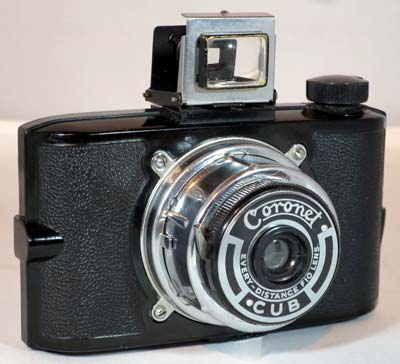Coronet Cub
Specification

| Manufacturer | : | Coronet |
|---|---|---|
| Produced | : | 1939 |
| Classification | : | Miniature |
| Body Type | : | Extending Solid Body |
| Construction | : | Bakelite/Metal |
| Film Type | : | 828 |
| Film Width | : | 35mm |
| ImageSize | : | 4 x 2.8 cm |
| No. of Images | : | 8 |
| Lens Type | : | Every Distance |
| Focus Type | : | Fixed |
| Focal Length | : | 50mm |
| Focal Range | : | 6ft - inf. |
| Aperture Type | : | Fixed |
| Aperture | : | f/10 |
| Shutter Type | : | leaf |
| Shutter Speeds | : | Instant *(1/68 sec) |
| Size Closed (w x h x d) | : | 115 x 75 x 45 mm |
| Size Open (w x h x d) | : | 115 x 92 x 57 mm |
| Weight | : | 270g |
| * measured on this camera | ||
Art Deco Credentials
![]()
![]()
![]()
Noteworthy: Worth giving special attention
I consider this camera to warrant 2 stars for the following attributes:
- Produced during the main Art Deco period
- Bakelite body with embossed leather style patterning
- Geometric pattern on lens plate
- Chrome extending lens barrel
- Chrome plated viewfinder
- Curvilinear shape
Description
The Coronet Cub is a fairly simple viewfinder camera and was made by Coronet in Birmingham, England. It appeared in several versions, starting in 1939. Each has a plastic body with a sprung telescoping front. The 1939 Cub has a optical folding frame viewfinder. The body is made from black Bakelite with embossed leather style patterning. The sprung telescopic lens barrel has a bayonet action. The barrel is twisted to release the barrel which automatically extends to the taking position. To retract the lens, simply press the lens in and twist to secure. When stored, the shutter is locked.
This camera has a simple meniscus f/10 lens. The shutter is single speed and can only do instantaneous shots. The film advance is by red window which has a sliding cover. It is not coupled to the shutter allowing double exposure. All Coronet Cubs use 828 film which produces 28x40mm images. There is no tripod mount.
How to Use
The user manual can be found here.
The film for this camera is not easily available. The Cub is NOT a 35mm camera. It was made for 828 film which is a paper backed film with a single registration hole per frame. The registration holes are not used by this camera for film advance. The film gate size is slightly larger than 35mm but the overall width of the film is the same. You have a number of options if you want to use this camera:-
- Use old expired film.
- Find some 828 backing paper and roll 35mm film in it.
- Cut down 120 film to fit.
What I suggest is to have fun with some expired film, keep the backing paper and spools, and then load it with 35mm film.
Using Expired Film

Old expired film can easily be found on the internet. However, there is usually no way of knowing how the film has been stored and so the results are variable. The secret is to over-expose old film. The general rule is one stop per decade for colour film and one stop per two decades for B&W.
Use 35mm film with 828 backing paper
If you have some 828 backing paper, it is possible to roll some 35mm film into it. You will need about 42cm of 35mm film. This can be taken from a 35mm film canister. You should be able to get 3 rolls of film from one canister. The film gate is larger than that of a 35mm camera so the image covers the sprocket holes giving a very nice effect. To do this, please refer to Use 35mm film in an 828 camera
If you don't want to bother with an exposure meter, follow the guide shown. It is based on the 'Sunny 16' rule. Film is so forgiving and will produce acceptable results even when overexposed by 2 or 3 stops or underexposed by 1 stop.
Remember that the exposure guide in the camera user manual may not be helpful as it is based on the use of old film with a low ISO value.
The tables assume that the sun is at least 30 degrees above the horizon - that's 10am - 5pm on a summer's day in the UK.
This camera has an f/10 aperture and a shutter speed of about 1/60s
The slow shutter speed means that you need to hold this camera steady when taking photographs.
Using ISO 100/125 film - shutter speed 1/60s
| Weather Conditions | Shadow Detail | Aperture | Exposure |
|---|---|---|---|
 Sunny SunnySnow/Sand | Dark with sharp edges | f/10 | +3 Stops Overexposed Acceptable |
 Sunny Sunny | Distinct | f/10 | +2 Stops Overexposed Acceptable |
 Slight Overcast Slight Overcast | Soft around edges | f/10 | +1 Stops Overexposed Acceptable |
 Overcast Overcast | Barely visible | f/10 | Good |
 Heavy Overcast Heavy Overcast | None | f/10 | -1 Stop Underexposed Acceptable |
 Open Shade Open Shade/Sunset | None | f/10 | -2 Stops Underexposed Not Acceptable |